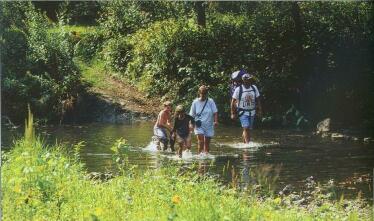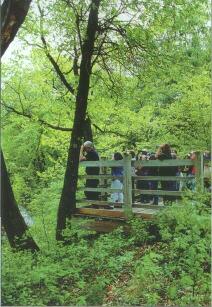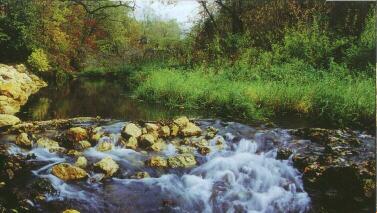|
A River Runs Through It
STORY BY BURKE SPEAKER
PHOTOS BY ADELE HODDE
For geological reasons, the
glaciers that more than
10,000 years ago crept across
Illinois, molding stoic rock formations and pancaking the land into
swelling prairies, paid no heed to
the state's northwestern corner. The
terrain remained unscathed by the
long-reigning icy lords, an oversight
that allowed several different landscape formations to be viewed
today. From rolling meadows to
rocky bluffs and shadowed canyons,
northwestern Illinois' Apple River
Canyon State Park encapsulates a
wealth of land formations, and touts
a noteworthy past that still resonates
across the land.
|
At Apple River
Canyon State Park, a
crystal-clear river
mirrors rocky bluffs
and a historic past
echoes throughout
the canyon.
|
Apple River Canyon State Park
is a wonder and indigenous marvel.
Located in eastern Jo Daviess
County near the Wisconsin border,
the area has great hiking, camping
and fishing. Deep ravines, natural
springs and gin-clear water characterize this 297-acre parcel. Though
the tranquil river may seem incapable of such a feat, the limestone
canyon walls were actually carved
by the meandering waters of Apple
River. It's a nature lover's paradise
and an explorer's dream.
"The areas in Jo Daviess County are unique in that they are in
this driftless area," said Site
Superintendent Jeff Hensal, referring to land that escaped the glaciers' iron. "This county has so
many different faces. It goes from
severe rock edges and canyons to
rolling hills; it's not like the flatlands in central Illinois. That's
why the area is so special."
Of Glacier Shadows Past
The land for Apple River Canyon
State Park was purchased in 1932
for the purpose of establishing a
public park and a place where the
unique characteristics of northwestern Illinois could be preserved. A
rich history predates that purchase,
with the wandering river always
being the central keynote feature.
Steadily flowing for numerous
centuries, Apple River eventually
sliced through the amassed limestone until the impressive 150-foot
cliffs and wide canyon you see
today gave rise. Later, water and
erosion scoured out crevices as
rivers and streams barreled their
way through the stone. All of this
activity led to the canyon's
redeeming luster and hidden beauty. Though to some people the
canyon may appear plain at first
glance, closer inspection reveals
walls adorned with dark green
mosses and lichens that cling like
dangling trapeze artists on the
jagged crevices.
|
July 2001 17

As they hike the trails, visitors
can enjoy many varieties of
wildflowers, including the
endangered bird's eye primrose
(bottom photo).
|

|
|
Because the glacial sweep ignored
this section of Illinois, it not only left
the terrain unflattened, but allowed
for easy access to vast lead vein
tracts. Historical accounts note that
the Native Americans of the region
used some of the natural lead mines.
A French trader named Nicholas Perrot, who settled on the east side of the
Mississippi in 1690, was the first
European to see these mines. But the
first to exploit them was Scotch
adventurer John Law. His 'Company
of the West,' founded in 1717 on a
false claim that the Illinois lead
mines were well-developed, fell apart
and later went down in history as the
"Mississippi Bubble."
An influx of settlers arrived at the
region in the 19th century, leading to
the region's rapid development. Soon,
Native Americans were viewed as a
nuisance, leading up to the banishment of the Sauk and Fox tribes following the Black Hawk War.
Nearby, Galena was quickly burgeoning in population as the lead
mines boomed, and people traveled
from far away to make their mark in
the area. As more people flocked to
the region, the town of Millville
was laid out in 1835 at the park's
present-day site. A blacksmith
store, several shops and a token tavern were all part of the unassuming
little village. |
The dominant features of Apple
River Canyon State Park are the
stream and rock bluffs. These park
visitors wade in the cool water of
a shallow pool.
Today, not a trace of
the town remains, save for a marker
that denotes its vanished existence.
Named after its two sawmills,
Millville flourished until 1854 when
the Illinois Central Railroad—building its line from Freeport to Galena—passed four miles north of the
town. The population waned until a
fierce flood in 1892 washed out the
dam, destroyed many buildings and
drove out the townspeople forever.
Apple River Activities
With newly resurfaced roads and
recent additions to make the site
more accessible, opportunities for
activities at the park are the best
they've ever been. There's a full
array of outdoor experiences to be
had, from camping beneath a star-filled sky to casting away a lazy
summer day.
Camping at Apple River Canyon
is a primitive experience though,
because no electricity or showers
are available. Consider the challenge of getting yourself immersed
in nature. Forget the television and
radio, and learn to understand the
heart of what camping is all about.
Apple River is a small stream, averaging
less than 30 feet wide through the state
park. Passing over the rocky stream bed,
there are stretches of fast water, shallow
pools and numerous riffle areas
|
|
18OutdoorIllinois
Information you can use:
Address: Apple River Canyon State
Park, 8763 E. Canyon Road, Apple
River, IL 61001.
Telephone: (815) 745-3302.
Website: http://dnr.state.il.us/lands/landmgt/parks/apple.htm
Directions: The park is located 2 1/2
hours west of Chicago. Take I-90a
West to US Rt. 20
for about 50 miles
 to Rt. 78 North.
Turn right onto
Rt. 78, go six
miles to Canyon
Road and take a
left on Canyon
Road. The park
is well signed on
Rt. 20 and Rt. 78. If
you are traveling
from the south, take I-
39 to Rockford, then US
Rt.20 West to Rt. 78 North, go six
miles to Canyon Road and take a left
on Canyon Road.
to Rt. 78 North.
Turn right onto
Rt. 78, go six
miles to Canyon
Road and take a
left on Canyon
Road. The park
is well signed on
Rt. 20 and Rt. 78. If
you are traveling
from the south, take I-
39 to Rockford, then US
Rt.20 West to Rt. 78 North, go six
miles to Canyon Road and take a left
on Canyon Road.
|

A scenic overlook in the state park
gives these visitors a spectacular
view of the Apple River and the
river valley.
|
You may see wild turkey or white-tailed deer trotting through the
woodlands during your stay, so
make the most of it. There are 50
class C campsites, including one
that is wheelchair accessible.
In addition to a primitive campground, the park offers trailer sites
with a sanitary station. Camping permits must be obtained from the park
staff. Likewise, a youth group camping area also is available, although
reservations are required. While
groups of 25 or more are welcome
and encouraged to use the park's
facilities, they must register in
advance with the site office to avoid
crowding or scheduling conflicts.
On warm summer mornings or
breezy, crisp fall afternoons, anytime is the right time for a picnic.
Four picnic areas with tables,
drinking water and toilets lie along
the river's banks, a perfect pit stop
for your park activities. There also
are three picnic shelters in case the
weather turns against you. Playground equipment is provided in
the youth group camping and main
picnic areas.
Though there are no swimming
areas at the site, the park offers
great fishing opportunities. Smallmouth bass, sunfish, crappie, carp
and suckers are all caught in the
pristine river. Also, DNR stocks
about 2,000 trout each, spring. Boating is not permitted in the park.
If you feel like abandoning the
great fishing for awhile, take to one
of five trails through the park, each
with a varying level of difficulty.
Pine Ridge, Tower Rock, River
Route, Sunset and Primrose trails all
wind through the woods, and each is
about a mile long. The easiest of the
five. Primrose Trail, is also one of
the best from which to view the
bluff and canyon. It is handicapped
accessible. The toughest one to trek
is Tower Rock, though the view is
more than worth the hike.

Wildlife watching is another
popular sport. While on the trails,
watch for deer, squirrels, rabbits,
raccoons, eagles, hawks and 47
other varieties of birds. At least 14
different ferns, more than 500 different herbaceous plants and 165
varieties of flowers can be viewed,
including the bird's-eye primrose,
an endangered plant that is found in
Canada and Alaska. Apple River
Canyon is the only place in the
state that has this unique plant that
can be seen along its bluffs.
In the fall, the multi-colored
leaves—in hues of gold, cardinal red
and bright orange—dance in the
breeze and dazzle with their rich
splendor. About anytime of the year,
Apple River Canyon offers something unique. So pack your outdoor
gear and go to where the glaciers
didn't. You'll discover an untouched
area of Illinois beauty.
|
Burke Speaker is a student at
Southern Illinois University. He
served as a summer intern with OutdoorIllinois
|
July 2001 19
|

